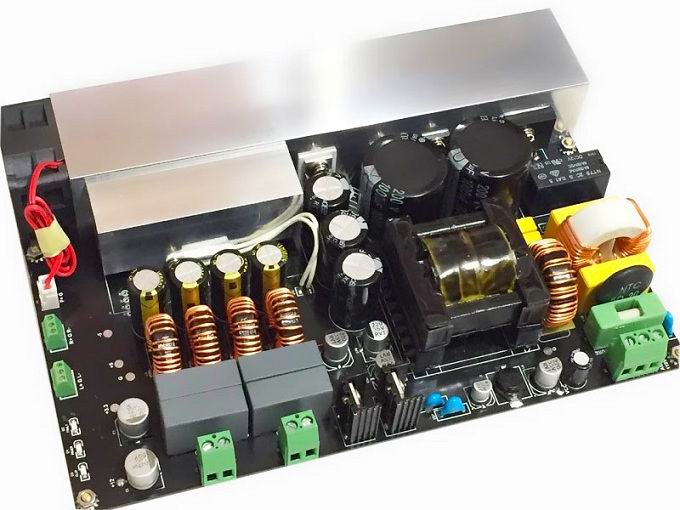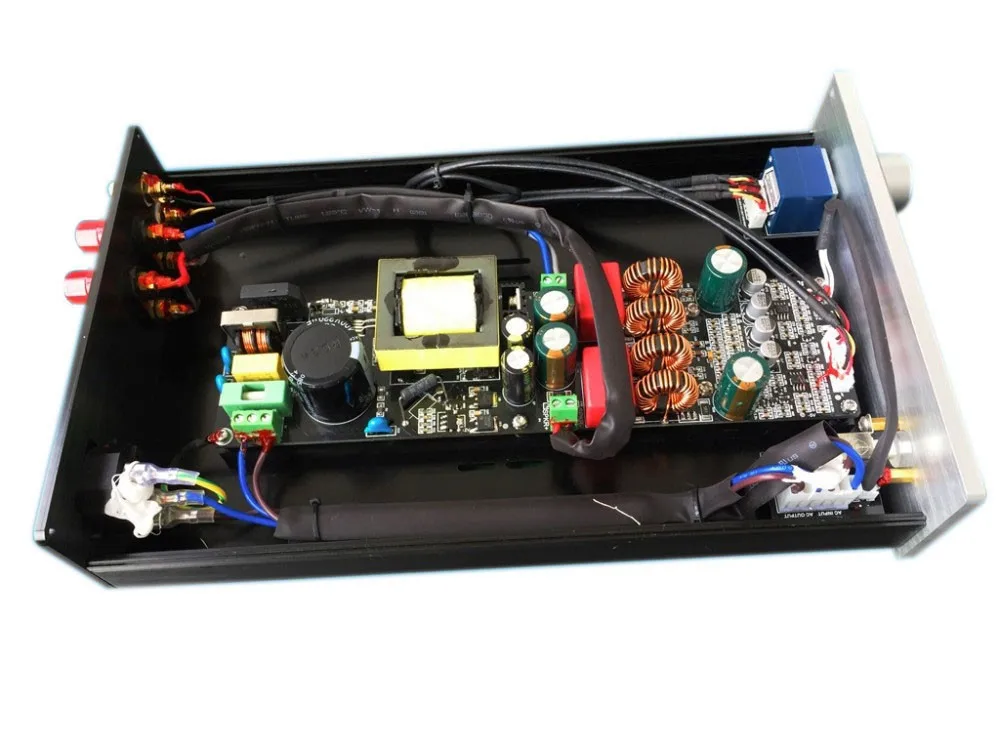The cheapest solution is to find the right transformer. 😉
It makes sense 😀
But the fact is that I own a SMPS 300RS 28V DC... So I guess that a DC > AC converter should exist ?
Maybye, but not by using the pins to connect the transformer.Hi amigos,
Question... do you think I can connect a SMPS 300RS 28 V directly to this TP3255 Board ?
The original one use a toroidal PSU (28V)
You can remove the diode bridge and solder pins to the + and - pads.
Do you already have the board, can you see how they use the diode bridge?
Hummmm thanks....
Could you suggest me any AC Power Supply that should work with it ? (recommended is 28V)
Or any DC AC converter I could find on Amazon ? Or any other cheap solution ?
You have a very nice amplifier board that can accept both AC and DC (if the DC supply remains stable with such capacitive loading). You now ask for a cheap solution. A cheap solution that gives you the full power of the amplifier board or only some of the potential power (like 60W in 8 Ohm)?
A cheap "brick" (DC) that can do 60W/8Ohm will cost around 20Euro. Another cheap way is to re-use the transformer from an old defective amplifier which I often buy for some 15Euro (the amplifier power may be close to full depending on the transformer you find).
Maybye, but not by using the pins to connect the transformer.
You can remove the diode bridge and solder pins to the + and - pads.
Do you already have the board, can you see how they use the diode bridge?
Can you show me via a a little diagram / drawing ?
I am waiting for the board... Should get it within 2 weeks now
It makes sense 😀
But the fact is that I own a SMPS 300RS 28V DC... So I guess that a DC > AC converter should exist ?
If you already own an SMPS 300RS 28V DC, you can try that one and see if it remains stable. 28Vdc will allow some 45W in 8 Ohm or 90W in 4 Ohm.
You can use an SMPS and connect it any which way to the power input. The rectifier will ensure the right polarity. No problem.
Just take care that the old system may be specified in AC voltage in. After rectification, this provides a DC voltage that is 1.4 times higher, in this case some 40V. To get the same power out of your amp, you would need a SMPS that delivers around 40V, not 28V if this is the case.
Just take care that the old system may be specified in AC voltage in. After rectification, this provides a DC voltage that is 1.4 times higher, in this case some 40V. To get the same power out of your amp, you would need a SMPS that delivers around 40V, not 28V if this is the case.
Sorry, I just read the other posts. There is no problem connecting a DC power source to the AC pins. You will just have some diode loss. And if you already have the SMPS, you can attach it without regard to polarity and it will work just fine. Better not solder on the board unless you are trained to do so.
PJVervoorn should limit his advise to matters he understands imo.
PJVervoorn should limit his advise to matters he understands imo.
The specs for this board says the secondary voltage should be between 24V and 31V AC.
24V AC is about 33V DC, after rectification.
So, the 28V DC is already below specced minimum. By foregoint the bridge, the poster will avoid unnecessary voltage drop.
24V AC is about 33V DC, after rectification.
So, the 28V DC is already below specced minimum. By foregoint the bridge, the poster will avoid unnecessary voltage drop.
I think my generic TPA3255 amp has more white noise in the right side because the bluetooth chipset and bluetooth DAC are on the right side. I accidentally severed the connection between bluetooth antenna and bluetooth chipset when I opened the amp. Because the bluetooth signal is stuck inside the case, it can add more white noise. I don't think I will buy soldering tools just to fix bluetooth in a cheap generic amp.
If you want to buy a generic amp, ideally buy one without bluetooth functionality.
If you want to buy a generic amp, ideally buy one without bluetooth functionality.
You can use an SMPS and connect it any which way to the power input. The rectifier will ensure the right polarity. No problem.
Just take care that the old system may be specified in AC voltage in. After rectification, this provides a DC voltage that is 1.4 times higher, in this case some 40V. To get the same power out of your amp, you would need a SMPS that delivers around 40V, not 28V if this is the case.
OK if I understand :
28V AC power = 40V DC Power
28V DC power = 19.6V AC Power
Right ? and I don't care about Polarity so
Last edited:
The specs for this board says the secondary voltage should be between 24V and 31V AC.
24V AC is about 33V DC, after rectification.
So, the 28V DC is already below specced minimum. By foregoint the bridge, the poster will avoid unnecessary voltage drop.
Hum guys... after a few research, I found this :
Seems that it is more complicated and it also depends on the Wattage.
Calculate AC to DC Amperage Through Inverter | BatteryStuff
For example (based on Genuine Linear PSU 28V AC @ 300VA ):


So I have to conclude that we care about the Voltage but also about the Wattage.
Can we say that a 24V DC @ 13.8A = a 36V DC @ 9.1A = 28V AC @ 10.7A (also = 28V DC @ 11.8A )??
Last edited:
Hum guys... after a few research, I found this :
Seems that it is more complicated and it also depends on the Wattage.
Calculate AC to DC Amperage Through Inverter | BatteryStuff
For example (based on Genuine Linear PSU 28V AC @ 300VA ):


So I have to conclude that we care about the Voltage but also about the Wattage.
Can we say that a 24V DC @ 13.8A = a 36V DC @ 9.1A = 28V AC @ 10.7A (also = 28V DC @ 11.8A )??
???? I get the impression you turn a rather straight-forward issue into something unnecessarily complicated.
The max. output power in the speaker depends on the supply voltage, the speaker impedance and the amplifier topology.
You use a class D amplifier in BTL configuration (we assume 90% efficiency) and we concern ourselves with one channel only:
((supply voltage)x(supply voltage))/(2x(speaker impedance)) should be the formula for calculating the power in a single speaker.
An example with 30V supply and a 6 Ohm speaker gives (30Vx30V)/(2x6 Ohm)=75W.
For the power supply, you multiply with the number of channels being supplied by this power supply and divide with 0.9 to account for the amplifier efficiency. That should be the total power needed from the power supply.
???? I get the impression you turn a rather straight-forward issue into something unnecessarily complicated.
The max. output power in the speaker depends on the supply voltage, the speaker impedance and the amplifier topology.
You use a class D amplifier in BTL configuration (we assume 90% efficiency) and we concern ourselves with one channel only:
((supply voltage)x(supply voltage))/(2x(speaker impedance)) should be the formula for calculating the power in a single speaker.
An example with 30V supply and a 6 Ohm speaker gives (30Vx30V)/(2x6 Ohm)=75W.
For the power supply, you multiply with the number of channels being supplied by this power supply and divide with 0.9 to account for the amplifier efficiency. That should be the total power needed from the power supply.
Thanks amigo ! Got it now 😀
Is it true that allo.com is going to release a TPA3255 amp at the beginning of next year?
It seems to be true... I read it in many other forums.
There is also this "non public" TPA3255 board with an integrated SMPS PSU.

Advanced Integrated Feedback Design with High-speed Gate Driver Error Correction (PurePath™ Ultra-HD)
Signal Bandwidth up to 100 kHz for High Frequency Content From HD Sources
Ultra Low 0.006% THD+N at 1 W into 4 Ω and <0.01% THD+N to Clipping
>65 dB PSRR (BTL, 1 kHz, No Input Signal)
<85 µV (A-Weighted) Output Noise
>111 dB (A Weighted) SNR
Click and Pop Free Startup and Stop
90% Efficient Class-D Operation (4 Ω)
Wide 18-V to 53.5V Supply Voltage Operation
Self-Protection Design (Including Undervoltage, Overtemperature, Clipping, and Short Circuit Protection) With Error Reporting
EMI Compliant When Used With Recommended System Design
Last edited:
Isn't this designed for AC mains operation? So why that
Best regards!
?Wide 18-V to 53.5V Supply Voltage Operation
Best regards!
Isn't this designed for AC mains operation? So why that ?
Best regards!
I think that the seller wrote the generic information about the TPA3255
Check it out :
TPA3255 AMP Module Integrated With High Efficiency SMPS - Sinewave Electronics Co.,ltd - ecplaza.net
This Board is made by SineWave Audio.
By the way, they also made a very serious version of the TPA3251 with a great internal PSU.

Balance Input 300W TPA3251PurePath Ultra HD Analog Input Class D Amplifier - Sinewave electronics co.,ltd
The design is inspired by the IcePower ICE125ASX2
Last edited:
Yes, most probably they just copied informations from the TI datasheet.
Query: How trustworthy can a (Chinese in addition) seller be who doesn't manage or want to publish specified data of his product?
Best regards!
Query: How trustworthy can a (Chinese in addition) seller be who doesn't manage or want to publish specified data of his product?
Best regards!
Yes, most probably they just copied informations from the TI datasheet.
Query: How trustworthy can a (Chinese in addition) seller be who doesn't manage or want to publish specified data of his product?
Best regards!
That's weird indeed..... But their Boards seem to be great. On the TPA3251 picture, you can see they use ELNA Capacitors and ALPS volume knob that's pretty cool.
- Home
- Amplifiers
- Class D
- TPA3255 - all about DIY, Discussion, Design etc